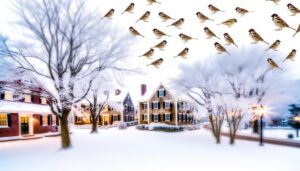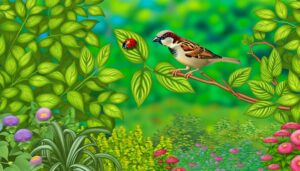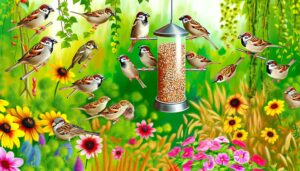How Many House Sparrows Are There in the World: A Step-by-Step Guide
Current scientific estimates suggest there are around 540 million house sparrows worldwide. This number is calculated from thorough field surveys, statistical models like mark-recapture and distance sampling, and technological tools such as satellite tracking and automated sound monitoring.
However, the global population trend indicates a noticeable decline, mainly due to urbanization, habitat loss, and environmental pollution. Regional differences exist, shaped by factors like food availability, nesting sites, and climatic conditions.
Advanced data integration from various survey methods guarantees strong population estimates crucial for successful conservation strategies. To comprehend the intricacies influencing these figures, consider delving deeper.

Key Takeaways
- Global house sparrow populations are significantly declining due to urbanization and habitat loss.
- Population estimates rely on surveys, statistical models, and tracking methods for accuracy.
- Regional variability in sparrow populations is influenced by environmental and anthropogenic factors.
- Conservation efforts include habitat restoration, targeted research, and public awareness campaigns.
- Reliable global population counts are challenging due to varying regional conditions and survey methods.
Estimating Sparrow Populations
Estimating sparrow populations involves a combination of field surveys, statistical modeling, and advanced technologies such as satellite tracking and automated sound monitoring.
Field surveys provide baseline data on sparrow densities in different habitats. Statistical models, including mark-recapture and distance sampling, are used to extrapolate this data, considering detection probabilities and environmental factors.
Satellite tracking provides insights into migration patterns and habitat use, improving spatial accuracy in population estimates. Automated sound monitoring systems capture vocalizations, allowing for continuous, non-intrusive data collection across large areas.
Integrating these methods leads to more robust and precise population estimates, which are crucial for effective conservation strategies and understanding ecological dynamics. This multifaceted approach ensures thorough population assessments, accounting for spatial and temporal variations.
Survey Methods
Survey methods for estimating house sparrow populations encompass a range of counting techniques such as point counts, transect walks, and citizen science initiatives.
Data collection challenges often include variations in habitat, observer bias, and temporal fluctuations in sparrow activity. These factors notably influence the accuracy of surveys, necessitating rigorous standardization and validation protocols.
Counting Techniques Used
Accurate population assessments of House Sparrows frequently rely on a variety of systematic survey methods. These include point counts, transect surveys, and mark-recapture techniques.
Point counts involve observers recording sparrows within a fixed radius, providing density estimates. Transect surveys entail walking predefined paths and noting sparrow sightings, thereby yielding data on population distribution and abundance.
Mark-recapture techniques involve capturing individuals, marking them with identifiable tags, and releasing them. Subsequent recaptures allow scientists to estimate population sizes using statistical models.
These methodologies, when used collectively, offer robust data on House Sparrow populations. This enables researchers to monitor trends, assess conservation status, and implement effective management strategies.
Accurate counts are essential for understanding population dynamics and informing policy decisions.
Data Collection Challenges
Conducting surveys to assess House Sparrow populations involves several challenges that can impact the reliability and accuracy of the collected data. Variability in habitat types, ranging from urban to rural settings, requires different survey methodologies, complicating standardization.
Temporal factors, such as breeding cycles and seasonal migrations, demand precise timing to capture accurate population snapshots. Observer skill variability introduces another layer of complexity, as inexperienced counters may underestimate or overlook certain individuals.
Technological limitations, especially in remote areas, hinder data collection efforts. Additionally, House Sparrows exhibit cryptic behavior, often nesting in concealed locations, making visual counts particularly arduous.
These challenges require robust, multi-faceted survey approaches to ensure thorough data acquisition for population assessments.
Survey Accuracy Factors
To address the numerous challenges highlighted in data collection, employing a variety of survey methods becomes necessary to enhance the accuracy and reliability of House Sparrow population assessments.
Utilizing point counts, transect surveys, and citizen science data can provide thorough insights. Point counts, conducted at fixed locations, offer snapshots of population density, while transect surveys, which involve systematic walks through habitats, yield detailed spatial distribution data.
Additionally, integrating citizen science platforms like eBird can significantly increase data volume and geographical coverage. Combining these methodologies mitigates individual biases and enhances overall data robustness.
Statistical models, such as distance sampling and mark-recapture, further refine population estimates, accounting for detection probability variations. This multifaceted approach guarantees a more precise and holistic understanding of House Sparrow populations globally.
Environmental Factors
Environmental factors greatly influence the distribution, behavior, and survival of house sparrows across diverse habitats. Key determinants include availability of food, nesting sites, and climatic conditions. Urban areas with abundant human activity provide ample food resources but often reduce nesting sites. Conversely, rural areas present more natural nesting opportunities but may lack consistent food availability. Climatic stressors such as severe winters or extreme droughts can significantly impact sparrow populations.
| Environmental Factor | Urban Areas | Rural Areas |
|---|---|---|
| Food Availability | High | Variable |
| Nesting Sites | Limited | Abundant |
| Climatic Stressors | Moderate (heat islands) | High (seasonal extremes) |
Understanding these factors is essential for conservation strategies aimed at stabilizing and potentially increasing house sparrow populations.
Global Population Trends
Recent studies indicate a significant decline in the global population of house sparrows, with factors such as urbanization and habitat loss contributing to this trend.
Additionally, regional population variability has been observed, with some areas experiencing more acute decreases than others.
Detailed data analyses reveal that these trends are influenced by a complex interplay of environmental and anthropogenic factors.
Population Decline Factors
The primary drivers behind the global population decline of house sparrows include urbanization, agricultural intensification, and pollution. Data indicate that urban areas see declines due to habitat loss and reduced food availability, exacerbated by modern architectural designs that lack nesting sites. Agricultural intensification leads to fewer insects, an essential food source, due to pesticide use. Pollution, particularly air quality degradation, affects respiratory health and reproductive success. Additionally, electromagnetic radiation from mobile towers is implicated in disrupting navigation and breeding patterns.
These factors vary across different regions and ecosystems based on local environmental conditions and human activities. While universally detrimental, they manifest differently, necessitating region-specific conservation strategies.
Regional Population Variability
The global population trends of house sparrows exhibit significant regional variability, influenced by a complex interplay of environmental factors, human activities, and ecological dynamics.
In North America, populations have seen a marked decline, linked to urbanization and pesticide use. Conversely, some regions in Asia report stable or increasing numbers, attributed to favorable agricultural practices and abundant food sources.
European populations display mixed trends; urban areas often witness declines due to habitat loss and pollution, while rural settings maintain healthier numbers. Studies indicate that habitat quality, food availability, and predation pressures are pivotal determinants.
In-depth, region-specific monitoring is essential for understanding these dynamics and implementing effective conservation strategies. This variability underscores the need for targeted, localized interventions to support global sparrow populations.
Regional Differences
Significant regional differences in house sparrow populations are evident in their varying behaviors, physical characteristics, and adaptation strategies across different geographic locations. These differences are essential for understanding the ecological and evolutionary dynamics of the species.
- Behavioral Variations: Sparrows in urban areas exhibit more aggressive foraging behaviors compared to their rural counterparts.
- Physical Differences: Northern populations often have larger body sizes, an example of Bergmann's rule.
- Dietary Adaptations: Sparrows in agricultural regions primarily consume grains, while urban sparrows have a more varied diet.
- Reproductive Patterns: In warmer climates, house sparrows may have more breeding cycles per year.
- Predation Risks: Varying predator types and densities influence sparrow behavior and population dynamics regionally.
These factors collectively highlight the adaptability and resilience of house sparrows in diverse environments.
Conservation Efforts
Efforts to conserve house sparrow populations have increasingly focused on habitat restoration, targeted research, and public awareness campaigns to address the species' decline in various regions.
Habitat restoration initiatives include planting native vegetation and creating urban green spaces, which provide crucial food and nesting resources.
Targeted research has identified factors like pesticide use, loss of insect prey, and urbanization as key drivers of population declines.
Public awareness campaigns aim to educate communities on the importance of biodiversity, encouraging citizen science projects to monitor sparrow populations.
Data from such initiatives have shown promising local population recoveries.
Collaborative efforts between conservation organizations, governments, and the public are essential for ensuring the long-term survival of the house sparrow.
Conclusion
Estimating the elusive global population of house sparrows necessitates nuanced methodologies and meticulous measurements. Survey strategies, spanning diverse regions, reveal significant sparrow statistics shaped by environmental elements.
Global trends indicate a disheartening decline, driven by habitat loss and urbanization. Regional disparities demonstrate differential densities and demographic dynamics.
Conservation campaigns, essential for curbing the crisis, focus on fostering favorable habitats and fortifying food sources. Such scientific scrutiny underscores the urgency of unified efforts to sustain sparrow species.






